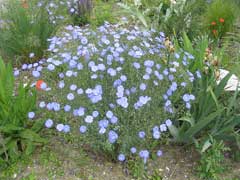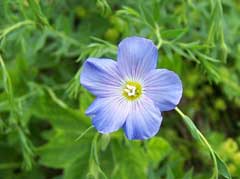 |
|
http://commons.wikimedia.org/wiki/User:Hagen_Graebner |
 |
| http://commons.wikimedia.org/wiki/User:Selso |
Translate this page:
Summary
Bloom Color: Blue, White. Main Bloom Time: Early summer, Late spring, Mid summer. Form: Upright or erect.
Physical Characteristics

 Linum perenne is a PERENNIAL growing to 0.3 m (1ft) by 0.2 m (0ft 8in) at a medium rate.
Linum perenne is a PERENNIAL growing to 0.3 m (1ft) by 0.2 m (0ft 8in) at a medium rate.
See above for USDA hardiness. It is hardy to UK zone 7 and is not frost tender. It is in flower from June to July, and the seeds ripen in August. The species is hermaphrodite (has both male and female organs) and is pollinated by Bees, flies.
Suitable for: light (sandy) and medium (loamy) soils and prefers well-drained soil. Suitable pH: mildly acid, neutral and basic (mildly alkaline) soils and can grow in very alkaline soils.
It cannot grow in the shade. It prefers dry or moist soil and can tolerate drought.
UK Hardiness Map
US Hardiness Map
Synonyms
L. lewisii. Pursh.
Plant Habitats
Cultivated Beds;
Edible Uses
Edible Parts: Oil Seed
Edible Uses: Oil
Seed - cooked[46, 61, 183]. A pleasant nutty taste and very nutritious[94]. The seed has a high oil content and can be eaten on its own or used as a flavouring[161, 183]. It should not be eaten raw because it contains cyanide but this is destroyed in the cooking process[183].
References More on Edible Uses
Medicinal Uses
Plants For A Future can not take any responsibility for any adverse effects from the use of plants. Always seek advice from a professional before using a plant medicinally.
Antirheumatic Carminative Emollient Ophthalmic Poultice Stomachic
The plant is antirheumatic, carminative and stomachic[94, 257]. The oil in the seed has soothing and lubricating properties, and is used in medicines to soothe tonsillitis, sore throats, coughs, colds, constipation, gravel and stones[244]. When mixed with an equal quantity of lime water it is used to treat burns and scalds[244]. A poultice of the fresh crushed leaves has been used to treat eye problems[94, 213]. A tincture of the entire plant is used in the treatment of diarrhoea[4]. The fresh herb is boiled and taken internally for the treatment of rheumatic pains, heartburn, colds, coughs and dropsy[4, 257]. A poultice of the plant is applied to bruises to reduce the swelling[257]. The seeds are emollient[240]. An eye medicine is made from them[257]. An infusion of the roots is used as an eyewash[257].
References More on Medicinal Uses
The Bookshop: Edible Plant Books
Our Latest books on Perennial Plants For Food Forests and Permaculture Gardens in paperback or digital formats.

Edible Tropical Plants
Food Forest Plants for Hotter Conditions: 250+ Plants For Tropical Food Forests & Permaculture Gardens.
More

Edible Temperate Plants
Plants for Your Food Forest: 500 Plants for Temperate Food Forests & Permaculture Gardens.
More

More Books
PFAF have eight books available in paperback and digital formats. Browse the shop for more information.
Shop Now
Other Uses
Cosmetic Fibre Hair Oil Paper
A drying oil is obtained from the seed. Used mainly for lighting[178], though it could also be used in all the ways that linseed oil (from Linum usitatissimum) is used - in paints, varnishes etc[115]. An infusion of the whole plant is used as a hair and skin wash[257]. It is said to be very beneficial to the skin and also to help prevent hair loss[257]. A good fibre is obtained from the stems, it is inferior to flax (Linum usitatissimum)[115] but is used for making cloth, nets, string, baskets, mats etc and in paper making[4, 46, 61, 74, 94, 115]. When used for paper making, the stems are harvested in late summer or autumn when they are two thirds yellow and are then retted[189]. The fibre is then stripped from the stem, cooked for two hours or more with lye and then beaten in a Hollander beater[189].
Special Uses
References More on Other Uses
Cultivation details
Landscape Uses:Alpine garden, Border, Container, Foundation, Massing, Rock garden. Prefers a light dry well-drained moderately fertile humus-rich soil in a sunny sheltered position[200]. Prefers an alkaline soil. Established plants are drought tolerant[190]. A very ornamental plant[1], it is not generally very long-lived though it normally self-sows freely[190]. The sub-species lewisii (which is seen as a separate species by some botanists or as no more than a synonym of this species by others) is more desirable for its fibre and has been cultivated by the N. American Indians for this purpose[155]. Special Features:
Naturalizing.
References Carbon Farming Information and Carbon Sequestration Information
Temperature Converter
Type a value in the Celsius field to convert the value to Fahrenheit:
Fahrenheit:
The PFAF Bookshop
Plants For A Future have a number of books available in paperback and digital form. Book titles include Edible Plants, Edible Perennials, Edible Trees,Edible Shrubs, Woodland Gardening, and Temperate Food Forest Plants. Our new book is Food Forest Plants For Hotter Conditions (Tropical and Sub-Tropical).
Shop Now
Plant Propagation
Seed - sow spring in greenhouse. When they are large enough to handle, prick the seedlings out into individual pots and plant them out in the summer. Basal cuttings in spring. Harvest the shoots when they are about 8 - 10cm long with plenty of underground stem. Pot them up into individual pots and keep them in light shade in a cold frame or greenhouse until they are rooting well. Plant them out in the summer.
Other Names
If available other names are mentioned here
Native Range
TEMPERATE ASIA: Russian Federation-Western Siberia (Western Siberia (south)) EUROPE: United Kingdom, Czechoslovakia, Austria, Switzerland, Germany, Hungary, Poland, Russian Federation-European part (European part (south)), Belarus, Moldova, Ukraine, Former Yugoslavia, Albania, Bulgaria, Greece, Italy, Romania, Spain (northeast), France
Weed Potential
Right plant wrong place. We are currently updating this section.
Please note that a plant may be invasive in one area but may not in your area so it's worth checking.
Conservation Status
IUCN Red List of Threatened Plants Status :

| Related Plants
|
| Latin Name | Common Name | Habit | Height | Hardiness | Growth | Soil | Shade | Moisture | Edible | Medicinal | Other |
| Allium pendulinum | | Bulb | 0.3 |
-
| | LM | S | M | 3 | 2 | 1 |
| Apium graveolens secalinum | Leaf Celery | Biennial | 0.6 |
-
| | LM | SN | M | 4 | 2 | 2 |
| Conioselinum pacificum | Pacific Hemlock-Parsley | Perennial | 0.0 |
-
| | LM | N | M | 2 | 1 | |
| Conioselinum vaginatum | | Perennial | 0.8 |
-
| | LMH | SN | M | 0 | 1 | |
| Gymnanthemum amygdalinum | Bitterleaf | Shrub | 8.0 |
10-12
| M | LMH | N | DM | 4 | 3 | 2 |
| Lilium pardalinum | Panther Lily, Leopard lily, Pitkin Marsh lily, Vollmer's lilyShasta lily, Wiggins' lily | Bulb | 2.0 |
5-9
| M | LMH | SN | MWe | 2 | 0 | 2 |
| Linum bienne | Pale Flax | Annual/Perennial | 0.6 |
6-9
| | LM | N | M | 0 | 0 | 2 |
| Linum catharticum | Purging Flax, Fairy flax | Annual | 0.3 |
0-0
| | LM | N | M | 0 | 2 | |
| Linum crepitans | | Annual | 0.6 |
-
| | LM | N | M | 0 | 0 | 1 |
| Linum humile | | Annual | 0.6 |
-
| | LM | N | M | 1 | 0 | 1 |
| Linum hybrids | Perennial Flax | Perennial | 0.8 |
7-11
| F | LMH | N | M | 4 | 4 | 4 |
| Linum marginale | Native Flax | Perennial | 0.6 |
-
| | LM | N | M | 1 | 0 | 1 |
| Linum monogynum | | Perennial | 0.6 |
7-10
| | LM | N | M | 0 | 0 | 1 |
| Linum strictum | | Annual | 0.4 |
5-9
| | LM | N | DM | 0 | 1 | |
| Linum usitatissimum | Flax, Common flax | Annual | 0.7 |
4-8
| | LM | N | M | 4 | 3 | 4 |
| Mesembryanthemum crystallinum | Ice Plant, Common iceplant | Perennial | 0.1 |
8-11
| | LMH | N | DM | 3 | 1 | 1 |
| Pedicularis sceptrum carolinum | Lousewort | Perennial | 1.2 |
-
| | LMH | SN | M | 1 | 1 | |
| Petroselinum crispum | Parsley | Biennial | 0.6 |
4-9
| M | LMH | SN | M | 4 | 4 | 3 |
| Petroselinum crispum tuberosum | Hamburg Parsley | Biennial | 0.6 |
6-9
| | LMH | SN | M | 4 | 3 | 3 |
| Petroselinum segetum | Corn Caraway | Biennial | 1.0 |
-
| | LMH | SN | M | 1 | 0 | |
| Peucedanum oreoselinum | | Perennial | 1.0 |
4-8
| | LMH | N | M | 0 | 1 | 1 |
| Pteridium aquilinum | Bracken, Western brackenfern, Decomposition brackenfern, Hairy brackenfern | Fern | 1.2 |
4-7
| F | LMH | SN | DM | 2 | 2 | 3 |
| Pteridium aquilinum esculentum | Bracken | Fern | 1.2 |
4-8
| | LMH | SN | DM | 2 | 2 | 3 |
| Talinum aurantiacum | Orange Flameflower | Perennial | 0.4 |
-
| | LMH | SN | M | 1 | 0 | |
| Talinum fruticosum | Tahitian Spinach, Waterleaf, Ceylon Spinach | Perennial | 0.5 |
8-11
| F | LMH | SN | DM | 3 | 2 | 1 |
| Thalictrum collinum | Lesser meadow-rue | Perennial | 0.0 |
0-0
| | LMH | SN | M | 0 | 1 | 0 |
|
Growth: S = slow M = medium F = fast. Soil: L = light (sandy) M = medium H = heavy (clay). pH: A = acid N = neutral B = basic (alkaline). Shade: F = full shade S = semi-shade N = no shade. Moisture: D = dry M = Moist We = wet Wa = water.
Now available:
Food Forest Plants for Mediterranean Conditions
350+ Perennial Plants For Mediterranean and Drier Food Forests and Permaculture Gardens.
[Paperback and eBook]
This is the third in Plants For A Future's series of plant guides for food forests tailored to
specific climate zones. Following volumes on temperate and tropical ecosystems, this book focuses
on species suited to Mediterranean conditions—regions with hot, dry summers and cool, wet winters,
often facing the added challenge of climate change.
Read More
Expert comment
Author
L.
Botanical References
200
Links / References
For a list of references used on this page please go here
Readers comment
© 2010, Plants For A Future. Plants For A Future is a charitable company limited by guarantee, registered in England and Wales. Charity No. 1057719, Company No. 3204567.